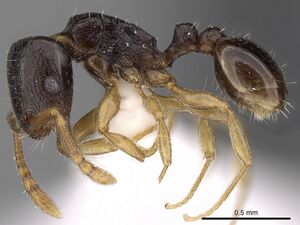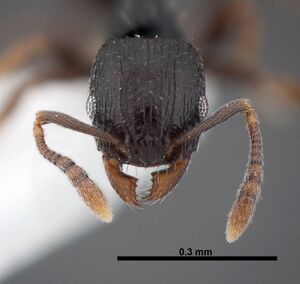Tetramorium nigrum
| Tetramorium nigrum | |
|---|---|

| |
| Scientific classification | |
| Kingdom: | Animalia |
| Phylum: | Arthropoda |
| Class: | Insecta |
| Order: | Hymenoptera |
| Family: | Formicidae |
| Subfamily: | Myrmicinae |
| Tribe: | Crematogastrini |
| Genus: | Tetramorium |
| Species: | T. nigrum |
| Binomial name | |
| Tetramorium nigrum Forel, 1907 | |
| Synonyms | |
| |
Found in a range of closed to semi-open habitats that include hardwood forest, bushveld, and miombo woodland. One collection was from shrubs and vegetation in a coastal area. Tetramorium nigrum have been found in a rotten log, litter and pitfall samples, and at a honey bait.
Identification
A member of the Tetramorium simillimum species group.
Bolton (1980) - This minute species resembles a small version of Tetramorium altivagans but is separated from it by lacking developed propodeal teeth and by having shorter antennal scapes (SI 84-91 in T. altivagans). Despite this I am not really sure that the differentiation is justified as a short series from Botswana, Okavango, collected by A. Russell-Smith matches T. nigrum (as represented by T. brevis holotype) in many respects but is intermediate in size between that species and T. altivagans and originates a great distance away from the localities noted above.
Keys including this Species
Distribution
Latitudinal Distribution Pattern
Latitudinal Range: -3.32° to -24.69924°.
| North Temperate |
North Subtropical |
Tropical | South Subtropical |
South Temperate |
- Source: AntMaps
Distribution based on Regional Taxon Lists
Afrotropical Region: Kenya (type locality), South Africa, Sudan, United Republic of Tanzania.
Distribution based on AntMaps
Distribution based on AntWeb specimens
Check data from AntWeb
Countries Occupied
| Number of countries occupied by this species based on AntWiki Regional Taxon Lists. In general, fewer countries occupied indicates a narrower range, while more countries indicates a more widespread species. |

|
Estimated Abundance
| Relative abundance based on number of AntMaps records per species (this species within the purple bar). Fewer records (to the left) indicates a less abundant/encountered species while more records (to the right) indicates more abundant/encountered species. |

|
Biology
Castes
Worker
Images from AntWeb
   
| |
| Worker. Specimen code casent0217972. Photographer Estella Ortega, uploaded by California Academy of Sciences. | Owned by FHGC, Francisco Hita Garcia Collection. |
   
| |
| Worker. Specimen code casent0235777. Photographer Shannon Hartman, uploaded by California Academy of Sciences. | Owned by AFRC, Pretoria, South Africa. |
   
| |
| Worker. Specimen code casent0280851. Photographer Estella Ortega, uploaded by California Academy of Sciences. | Owned by NHMUK, London, UK. |
   
| |
| Worker. Specimen code fmnhins0000047311. Photographer Stephanie Ware, uploaded by Field Museum. | Owned by FMNH. |
Nomenclature
The following information is derived from Barry Bolton's Online Catalogue of the Ants of the World.
- nigrum. Tetramorium pauper subsp. nigrum Forel, 1907a: 15 (w.) KENYA. Raised to species and senior synonym of brevis: Bolton, 1980: 316.
- brevis. Tetramorium brevis Weber, 1943c: 370 (w.) SUDAN. Junior synonym of nigrum: Bolton, 1980: 316.
Unless otherwise noted the text for the remainder of this section is reported from the publication that includes the original description.
Bolton (1980) - The problem of how many species are represented here is unable to be solved at present and will have to await the amassing of more material in this complex from all over eastern and southern Africa. Despite this confusion I feel fairly certain of the synonymy of T. nigrum with T. brevis as Weber’s holotype matches Forel’s original description of T. nigrum very well.
Description
Worker
Bolton (1980) - TL 1.9, HL 0.52, HW 0.44, CI 85, SL 0.34, SI. 77, PW 0.30, AL 0.55.
Mandibles mostly smooth but with delicate traces of striation. Anterior clypeal margin without a median notch, regularly arcuate. Frontal carinae feeble but extending back beyond the eyes, posteriorly no more strongly developed than the remaining cephalic sculpture. Antennal scrobes vestigial. Eyes of moderate size, maximum diameter 0.11, about 0.25 x HW and with 7 ommatidia in the longest row. Propodeum in profile sharply descending posteriorly, the dorsum and declivity separated only by an angle or a pair of minute tubercles, without triangular teeth. Petiole node in dorsal view broader than long. Dorsum of head irregularly and finely longitudinally rugulose, the ground-sculpture a fine superficial punctulation or shagreening. Dorsal alitrunk with a similar ground-sculpture to that of head, overlaid by numerous fine, short longitudinal rugulae. Petiole and post-petiole finely punctulate and with vestigial traces of rugular sculpture. First gastral tergite smooth and shining. All dorsal surfaces of head and body with scattered short, stout, blunt hairs. Colour dark brown, the appendages yellow-brown.
Type Material
Bolton (1980) - Holotype worker, KENYA: Mto-ya-Kifaru (Katona) (type not found). Holotype worker, SUDAN: Imatong Mts, W. slopes, 2.viii.1939, 5600 ft [1710 m], no. 1405 (N. A. Weber) (Museum of Comparative Zoology) [examined].
References
- Bolton, B. 1980. The ant tribe Tetramoriini (Hymenoptera: Formicidae). The genus Tetramorium Mayr in the Ethiopian zoogeographical region. Bulletin of the British Museum (Natural History) Entomology. 40(3):193-384.
- Forel, A. 1907d. Formicides du Musée National Hongrois. Ann. Hist.-Nat. Mus. Natl. Hung. 5: 1-42 (page 15, worker described)
References based on Global Ant Biodiversity Informatics
- Bolton B. 1980. The ant tribe Tetramoriini (Hymenoptera: Formicidae). The genus Tetramorium Mayr in the Ethiopian zoogeographical region. Bulletin of the British Museum (Natural History). Entomology 40: 193-384.
- Garcia F.H., Wiesel E. and Fischer G. 2013.The Ants of Kenya (Hymenoptera: Formicidae)Faunal Overview, First Species Checklist, Bibliography, Accounts for All Genera, and Discussion on Taxonomy and Zoogeography. Journal of East African Natural History, 101(2): 127-222
- Weber N. A. 1943. The ants of the Imatong Mountains, Anglo-Egyptian Sudan. Bulletin of the Museum of Comparative Zoology 93: 263-389.

